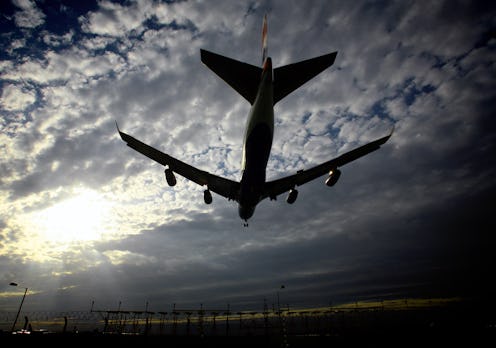News
Turbulence Sucks, But Is It Dangerous?
For nervous fliers, there are few things scarier than turbulence. And if Tuesday's news is anything to go by, they're right to be afraid: A United Airlines flight hit severe turbulence that sent three flight attendants and two passengers to the emergency room Monday. The flight was traveling from Denver, Colorado to Billings, Montana, and one woman hit her head on the ceiling so hard it cracked a panel. So how dangerous is turbulence, exactly?
Believe it or not, there was more than one incident of severe on-board turbulence Monday. Two flight attendants and several passengers were injured during severe turbulence on board a Cathay Pacific flight from San Francisco to Hong Kong Monday. Some of the injured travelers were carried off the jumbo jet on stretchers.
But before you panic and cancel your springtime vacation, here are a few things you should know about turbulence.
HOW COMMON IS TURBULENCE?
Very. British Airways pilot Steve Allright told the Telegraph newspaper he expects at lease a little turbulence every time he flies. He explains that flight crews separate turbulence into three categories: light, moderate and severe.
Allright likens light turbulence to bumps in the road — a minor inconvenience, at most.
Moderate turbulence strikes no fear into pilots, as they will experience this level of turbulence for a few hours in every thousand hours they fly. It usually lasts for no more than 10 or 15 minutes, but occasionally may last for several hours, on and off. This sort of turbulence will unsettle even some regular travellers and will cause drinks to spill. The aircraft may be deviating in altitude by 10 or 20 feet. No action is required by the pilot to control the aircraft, but the flight crew may decide to try a different altitude if the turbulence persists.
Severe turbulence is extremely rare. In a flying career of over 10,000 hours, I have experienced severe turbulence for about five minutes in total. It is extremely uncomfortable but not dangerous. The aircraft may be deviating in altitude by up to 100 feet (30 metres) or so, up as well as down, but nothing like the thousands of feet you hear some people talking about when it comes to turbulence.
It's not dangerous unless you happen to be wandering about the cabin, in which case there's a chance you could go flying (excuse the pun). According to the Federal Aviation Administration, around 58 people are injured every year due to turbulence. The majority of these people are flight attendants, as they're much more likely to be moving around the cabin when turbulence strikes.
CAN TURBULENCE CAUSE A PLANE CRASH?
Theoretically, yes, but realistically, not really. The way modern aircraft are designed means it's virtually impossible for turbulence to knock a plane out of the sky.
Virtually impossible... but not completely. A severe thunderstorm can create updrafts violent enough to send a plane out of control. Fortunately, technology means pilots can see these storms coming from a long way off and change their course accordingly.
Remember, although bad turbulence might mean you end up with your gin and tonic in your lap, the likelihood of the plane hurtling back towards the earth is negligible.
WHAT'S THE NUMBER ONE PIECE OF ADVICE?
Wear a seatbelt. Yeah, we know, not exactly earth-shattering, but if you don't fancy smacking your head on the ceiling during a severe bout of turbulence, then buckle up. Pilots have their seatbelts fastened all the time. That means you should too.
